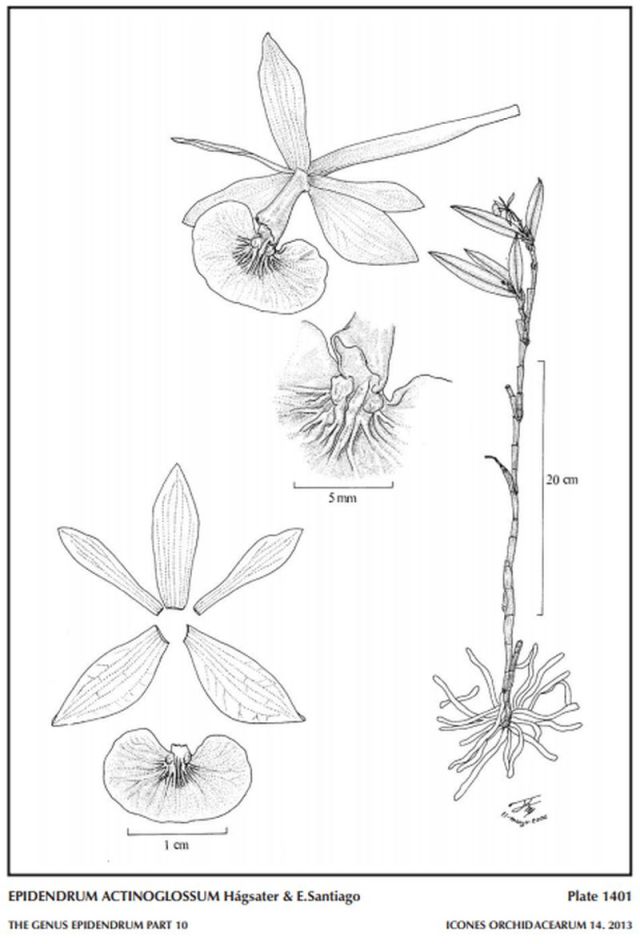

Epidendrum actinoglossum Hagsater & Santiago 2013 GROUP Arbuscula SUBGROUP Incomptum
TYPE Drawing by © Jimenez, Hágsater & E.Santiago and The AMO Herbario Website


 LATE
LATE  EARLY
EARLY 
Common Name The Radiating Tongue Epidendrum [refers to the radiating calli of the lip]
Flower Size .8" [2 cm]
Found in Ecuador and Peru on the lower eastern slopes of the Andes at elevations around 800 to 1300 meters as a medium sized, warm to cool growing epiphyte with erect, simple, cane-like, terete, thin, straight stems enveloped basally by tubular, non-foliaceous sheaths and carrying about 2 to 3, at the apex of the stem, unequal in size, subcoriaceous, narrowly elliptic, acute, basally clasping leaves that blooms in the late spring and early summer on a terminal, occuring only once, .44 to .68" [1.1 to 1.7cm] long, arching-nutant, thin, laterally compressed, straight, 4 to 5, apparently successive flowered inflorescence with narrowly triangular, acuminate, amplexicaul, much shorter than the ovary floral bracts and carrying resupinate flowers.
"Epidendrum actinoglossum belongs to the GROUP Arbuscula which is characterized by the erect habit with successive lateral growths produced from the middle of the previous growth, few leaves aggregate towards the apex of the stems, roots generally only from the base of the primordial stem, and the SUBGROUP Incomptum which has a short apical inflorescence with fleshy yellowish to green to violet-green to black flowers with short ovaries, the lip entire to 3- lobed. The species is recognized by the green flowers, or the sepals green and the lip salmon-yellow, the apex of the column tinged purple and the prominent clinandrium-hood, the floral bracts are much shorter than the ovary, and the lip is reniform, rounded, the apex is not emarginate, and the disc has numerous, short, thickened veins, radiating from the base of the lip. Epidendrum nephroglossum Schltr. has yellow flowers sometimes tinged greenish at the base, prominent floral bracts nearly as long as the ovary, the reniform lip, cordate at the base, the apex shallowly emarginate (not visible unless the lip is extended), somewhat longer than wide, with a pair of fleshy, low calli at the base, and the disc is glabrous, without any thickened veins." Hagsater etal 2013
Synonyms
References W3 Tropicos, Kew Monocot list , IPNI ; * Icones Orchidaceaerum 14 Plate 1401 Hagsater 2013 drawing fide; Icones Orchidacearum 14 Plate 1461 Hagsater & Sanchez 2013 see recognition section;
--------------------------------------------------------------------------------------------------------------------------
----------------------------------------------------------------------------------------------------------------------------